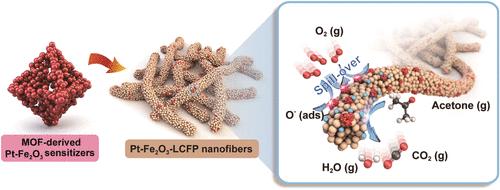Our official English website, www.x-mol.net, welcomes your
feedback! (Note: you will need to create a separate account there.)
Vitalizing Perovskite Oxide-Based Acetone Sensors with Metal–Organic Framework-Derived Heterogeneous Oxide Catalysts
ACS Sensors ( IF 8.2 ) Pub Date : 2024-11-01 , DOI: 10.1021/acssensors.4c01852 Minhyun Kim, Seyeon Park, Jaewan Ahn, Jong Won Baek, Dong-Ha Kim, Hamin Shin, Jaehyun Ko, Lu Song, Chungseong Park, Euichul Shin, Il-Doo Kim
ACS Sensors ( IF 8.2 ) Pub Date : 2024-11-01 , DOI: 10.1021/acssensors.4c01852 Minhyun Kim, Seyeon Park, Jaewan Ahn, Jong Won Baek, Dong-Ha Kim, Hamin Shin, Jaehyun Ko, Lu Song, Chungseong Park, Euichul Shin, Il-Doo Kim

|
Perovskite oxides are promising candidates for chemiresistive-type gas sensors owing to their exceptional thermal and chemical stability during solid–gas reactions. However, perovskites suffer from critical issues such as low surface area and poor surface activity, which negatively influence the sensing characteristics. While metal nanoparticles can be incorporated in perovskites to improve their reactivity, the fundamental incompatibility between catalytic metals and perovskite oxides often leads to substantial structural degradation as well as phase instability. Herein, we overcome this challenge through the introduction of an intermediary phase that forms coherent interfaces with both the perovskite phase and catalyst metals. Specifically, we present the case study of p-type La0.8Ca0.2Fe0.98Pt0.02O3 perovskite, whose hole accumulation layer was modulated by the incorporation of metal–organic framework (MOF)-derived n-type α-Fe2O3 nanoparticles decorated with highly dispersed Pt catalysts. The resulting composite exhibited significantly improved surface activity over the nonmodified La0.8Ca0.2FeO3 perovskite, leading to exceptional chemiresistive sensing performance toward acetone gas (Rg/Ra = 39.8 toward 10 ppm of acetone at 250 °C) with high cross-sensitivity against interfering gases. Importantly, our findings reaffirm the critical influence of interfacial engineering in facilitating surface chemical reactions on perovskite oxides and, by doing so, effectively provide a general synthetic guideline to the design of perovskite-based chemiresistors.
中文翻译:

使用金属有机框架衍生的非均相氧化物催化剂使基于钙钛矿氧化物的丙酮传感器充满活力
钙钛矿氧化物因其在固-气反应过程中出色的热稳定性和化学稳定性而成为化学电阻型气体传感器的有前途的候选者。然而,钙钛矿存在表面积小和表面活性差等关键问题,这些问题会对传感特性产生负面影响。虽然金属纳米颗粒可以掺入钙钛矿中以提高其反应性,但催化金属和钙钛矿氧化物之间的基本不相容性通常会导致严重的结构降解和相不稳定。在此,我们通过引入与钙钛矿相和催化剂金属形成相干界面的中间相来克服这一挑战。具体来说,我们介绍了 p 型 La0.8Ca0.2Fe0.98Pt0.02O3 钙钛矿的案例研究,其空穴积累层是通过掺入金属有机框架 (MOF) 衍生的 n 型 α-Fe2O3 纳米颗粒修饰的高效分散的 Pt 催化剂。与未改性的 La0.8Ca0.2FeO3 钙钛矿相比,所得复合材料的表面活性显著提高,因此对丙酮气体具有出色的化学电阻感应性能(在 250 °C 下对 10 ppm 丙酮的 Rg/Ra = 39.8),对干扰气体具有很高的交叉敏感性。重要的是,我们的研究结果再次证实了界面工程在促进钙钛矿氧化物表面化学反应方面的关键影响,并通过这种方式有效地为基于钙钛矿的化学电阻器的设计提供了一般的合成指南。
更新日期:2024-11-04
中文翻译:

使用金属有机框架衍生的非均相氧化物催化剂使基于钙钛矿氧化物的丙酮传感器充满活力
钙钛矿氧化物因其在固-气反应过程中出色的热稳定性和化学稳定性而成为化学电阻型气体传感器的有前途的候选者。然而,钙钛矿存在表面积小和表面活性差等关键问题,这些问题会对传感特性产生负面影响。虽然金属纳米颗粒可以掺入钙钛矿中以提高其反应性,但催化金属和钙钛矿氧化物之间的基本不相容性通常会导致严重的结构降解和相不稳定。在此,我们通过引入与钙钛矿相和催化剂金属形成相干界面的中间相来克服这一挑战。具体来说,我们介绍了 p 型 La0.8Ca0.2Fe0.98Pt0.02O3 钙钛矿的案例研究,其空穴积累层是通过掺入金属有机框架 (MOF) 衍生的 n 型 α-Fe2O3 纳米颗粒修饰的高效分散的 Pt 催化剂。与未改性的 La0.8Ca0.2FeO3 钙钛矿相比,所得复合材料的表面活性显著提高,因此对丙酮气体具有出色的化学电阻感应性能(在 250 °C 下对 10 ppm 丙酮的 Rg/Ra = 39.8),对干扰气体具有很高的交叉敏感性。重要的是,我们的研究结果再次证实了界面工程在促进钙钛矿氧化物表面化学反应方面的关键影响,并通过这种方式有效地为基于钙钛矿的化学电阻器的设计提供了一般的合成指南。


















































 京公网安备 11010802027423号
京公网安备 11010802027423号